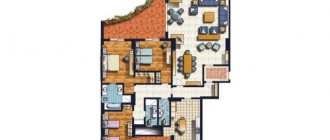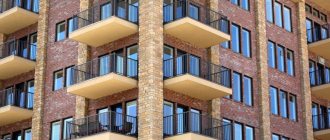In the modern world, transactions involving the purchase of real estate regularly occur. In order to avoid getting into an unpleasant situation, you need to be thoroughly prepared for such a transaction. Many people are interested in what the total area of a room or apartment is, and how this indicator is determined. This question is especially important for those who plan to sell or buy real estate in the near future.
Practice shows that this indicator directly affects the cost of housing. The larger the total area, the correspondingly higher the cost of housing. However, here it is necessary to understand all the features regarding the size of the living space. Only then will you be able to essentially assess how well the chosen apartment meets the requirements.
Main components
You may be interested in: Why do you need a current account for an individual entrepreneur? Cashless payment for individual entrepreneurs. Where is it more profitable to open a current account for individual entrepreneurs?
The calculation of the total area of the apartment is carried out according to several indicators. Three characteristics can be distinguished:
- living space;
- general;
- apartment area.
You may be interested in: Transport tax for 150 liters. With. - calculation formula and payment terms
Without taking into account these indicators, it is impossible to say exactly what residential real estate is. Therefore, when purchasing, be sure to clarify this information. If you know what is included in each type of room area, then you will not be afraid of deception when concluding real estate transactions.
total area
What do you need to know about this? The first thing you should decide on is the total area of the apartment. These may or may not be habitable. These may simply be premises that are directly related to the proposed property. Often sellers and real estate agents resort to tricks and indicate the total area of the premises as living space. This is not entirely true, since it also includes balconies and loggias. Therefore, this parameter must be specified separately.
Determining the area of an apartment purchased under an equity participation agreement
At the moment, there is no method for determining the cost of apartments under an equity participation agreement. Typically, builders determine the cost based on the share of the living area in the total area of all apartments in the building under construction.
The share participation agreements indicate the projected area of housing, including:
- living space;
- area of auxiliary premises;
- balconies and loggias.
In this regard, there may be cases when the actual area of the transferred residential premises differs from the design area specified in the contract.
If in the contract the parties provided for the possibility of increasing the area and the procedure for making an additional payment in connection with this, then such a deviation is not considered a violation of the rights of the participant in shared construction, since the magnitude of the deviation does not indicate a deviation by the developer from the terms of the contract and the unsuitability of the residential premises for habitation.
If the share participation agreement does not contain a clause on a possible increase/decrease in the actual area, then the participant has the right to go to court with claims against the developer for the return of the overpaid amount. The court will calculate the amount of money taking into account the size of the total area of the apartment, calculated according to the rules of Art. 15 Housing Code of the Russian Federation.
Example
N. filed a claim for recovery from the developer of overpaid funds under the agreement for participation in shared construction. N. entered into a share participation agreement with the developer; upon completion of construction, the developer was to transfer to N. a one-room apartment, the size of which was 50 m2, the living area was 38 m2, and the balcony was 5 m2.
The cost of the apartment was calculated based on the entire area of the apartment, without using coefficients. N. signed the apartment acceptance certificate without any comments and did not express any complaints regarding the execution of the contract. The parties did not indicate in the agreement that they would apply a reduction factor to the calculation of the balcony area.
In accordance with the “Instructions on accounting of housing stock in the Russian Federation” dated 08/04/1998, a coefficient of 0.3% is applied for balconies and terraces. Accordingly, the price of the apartment had to be calculated taking into account the specified coefficient. In this regard, the court recognized I.’s claims as legitimate and satisfied the claim.
Living space
Let's look at this in more detail. What applies to the living space of an apartment? First of all, you need to know what is meant by this term. Living space, as you might guess, is a space suitable for human habitation. It would seem nothing complicated. However, many have difficulty answering what is included in this area.
You will be interested in: Residential complex "Bereg", Khimki - review, features, layout and reviews
To fully understand what each of the three areas includes, you need to consider one more concept - the area of the apartment. This refers to the entire room. This includes both a balcony and a loggia. Such space is still considered useful. The concept of usable area also includes various mezzanines. It is important to avoid confusion here. In foreign countries, usable area refers to all residential premises used.
Calculation of the total and living area of the apartment
The legislator provides for various methods for calculating the total and living area of housing, depending on the purposes for which this calculation is made:
- In accordance with the Housing Code of the Russian Federation, total is defined as the total amount of all residential and auxiliary premises.
- According to statistical observation of finished construction products and methods for assessing the activities of local governments, the total area is the area of all residential and utility rooms and the area of verandas, terraces, loggias, balconies, calculated with reducing factors (balconies, terraces - 0.3%, loggias - 0.5%, verandas and cold storage rooms - 1%).
- Living area is defined as the sum of all residential premises . Utility rooms, loggias, balconies, terraces, verandas are not taken into account when calculating living space.
Components
The total area of the apartment is not only the premises suitable for living. Living space includes only rooms. The larger they are, the higher this indicator. It is worth considering that the bathroom does not belong to the living space, since you cannot live in it. Although this is a necessary place in any apartment.
It should also be noted that the kitchen is not included in the living area. This is not entirely correct from a logical point of view, but it is better to take this feature into account. Many sellers today are trying to increase the size of their living space by adding a kitchen, as well as loggias and bathrooms.
Calculation rules
As you already understand, living space is considered the main indicator influencing the value of real estate. Let's try to figure out how it is calculated. This point is very important. A component of this space is the room in which you can live. Therefore, to calculate the living area of a room, it is enough to simply add together the footage of all the rooms. The result should be the required indicator. To calculate the area of a room, you should use simple mathematical formulas. Measurements are taken on the inside of the baseboard.
What rooms are included in the total area?
Let's look at this in more detail. Often when purchasing residential real estate, the question arises: is the loggia included in the total area of the apartment? It is advisable for everyone to know this, since this indicator plays a fairly important role. It can be used to judge how much space is allocated for the needs of residents, and not just for living. Such premises include:
- toilet;
- bathroom;
- hallway;
- bedrooms;
- living room;
- wardrobe;
- other utility rooms.
Loggias and balconies should not be added to the total area of the premises. Based on the Housing Code of the Russian Federation, the rooms in question do not belong to the apartment at all. Often buyers are not aware of this norm, which leads to negative consequences.
You may be interested in: Is it possible to donate change to Sberbank? Exchange of small coins for banknotes at Sberbank: options and procedure
How is the area of stairs and niches calculated? They can be included in the common space of the apartment, but under certain conditions. In addition to premises, this indicator includes:
- niches whose height is at least 2 meters;
- stairs located in the apartment and the space under them;
- arches more than 2 meters high;
- protruding elements.
Differences between areas
This aspect needs to be given special importance. How is the total area of a two-room apartment determined? What indicators are taken into account? There are certain differences between the living area and the common area that should definitely be taken into account. These include:
- Number of square meters: living area is only a component of the total. For this reason, its footage should be much smaller. Sometimes these indicators may differ from each other by a factor of two.
- Premises included in the total area: living rooms include rooms for sleeping and relaxation (bedrooms, children's rooms, guest rooms). General covers all rooms in the apartment.
- Possibility of use: the possibility of receiving subsidies, adopting a child, and so on depends on the size of the living space. The total area affects the market value of housing, the amount of utility bills and the amount of contributions for major repairs.
How to determine
To find out what the living area is, you need to calculate the number of square meters of the entire space intended for living. This:
- hall (guest room);
- master bedrooms;
- children's.
To obtain the quantity, each space is calculated separately. For example, in a one-room apartment this area is proportional to the parameters of the only room - the bedroom-living room, in a two-room apartment - the bedroom and living room.
Important!
Some people mistakenly attribute the kitchen or loggia to this space. But according to the Housing Code, this is a mistake. The dining area cannot be considered suitable for living, even if there is a bed there.
Non-residential area - the remaining space, including a corridor, kitchen, bathroom (bathtub and toilet), balcony, loggia. This includes storage rooms, hallways, and dressing rooms.
Complete turnkey apartment renovation
- Everything is included The cost of repairs includes everything: work, materials, documents.
- Without your participation After agreeing on the project, we only bother the owners when the repairs are completed.
- The price is known in advance. The cost of repairs is fixed in the contract.
- Fixed repair period Turnkey apartment renovation in 3.5 months. The term is fixed in the contract.
Read more about Done
Instructions for calculating the area of an apartment
So what do you need to know about this? Today, many are interested in how the total area of a 2-room apartment is calculated. In order to independently determine this characteristic of the room, you will need:
To learn how to take measurements yourself, you will need a tape measure and a calculator. It will be more convenient to take measurements if someone helps you.
First, draw a diagram of the apartment on a piece of paper. This will make it easier for you to enter the values on the plan. Don’t forget to take measurements in utility rooms – corridors, closets, and so on. It is necessary to measure the length of the premises according to the level of the baseboard. To do this, make sure that the tape measure is tensioned well and accurately. The sums of all measurements must be converted into meters and written down on a piece of paper. If the room has an irregular shape with protrusions, corners and curves, then it will be easier to divide the plan into separate figures and indicate their sizes on the diagram.
The length and width of each room should be multiplied and recorded on the plan. When you add up the areas of all the rooms, you should get a total.
The concept of apartment living space
The living area of premises is the sum of the areas of all living rooms (Order of the Ministry of Land Construction of the Russian Federation dated 08/04/1998 No. 37). If necessary, it can be increased due to auxiliary premises (corridor, storage room, as well as a loggia, balcony, terrace, etc.). Such an increase occurs due to its redevelopment or reconstruction of the house .
In accordance with Part 2 of Art. 25 of the Housing Code of the Russian Federation, redevelopment is a change in the configuration of the apartment and, as a result, making adjustments to the technical passport of the apartment.
Redevelopment is carried out in compliance with current legislation and requires permission from local governments.
For this reason, failure to comply with the redevelopment procedure (obtaining permission from local authorities, making changes to the technical passport, etc.) may lead to its recognition as illegal.
Reconstruction of a house is a change in its size, number of floors, area, addition, rebuilding of the house. Due to the fact that the reconstruction affects the load-bearing building structures of the house, it is necessary building permit
In the case of reconstruction of a house with the eviction of the tenant, the landlord is obliged to provide the citizen and his family with another living space for the duration of the reconstruction. At the same time, the social rental agreement remains in force, and after reconstruction is completed, the tenant has the right to return to his previous housing (Article 88 of the Housing Code of the Russian Federation).
Loggias and balconies
What do you need to know about them? Many people believe that the loggia is included in the total area of the apartment, but the balcony is not. Although the differences between these two concepts are unclear, they should not be ignored, as this can lead to serious legal consequences. By uniting, residents of the house can donate the outer part of the loggias and balconies for use for advertising purposes. In some cases this brings good income.
Calculation coefficients
It is easy to determine the living area - just take the total value of square meters in all rooms that fit this definition. Additionally, certain coefficients specified in SNiPs are taken into account. Each room has its own.
If for some reason the dimensions of the loggia are calculated, a coefficient of 0.5 is applied. For balconies and terraces – 0.3. For buildings that have verandas, a coefficient of 1 is provided. The same figure is used when cold (unheated) storerooms are taken into account.
The calculations are easy, just add the meters of each room. True, this rule only applies if the shape of the room is correct (geometrically proportional square, rectangle). If not, you need to measure along the walls with a tape measure.
Interesting fact!
You need to measure the area of the walls using the inside of the baseboard. If you don’t want to do this, you can ask for an extract from the BTI. The exact values for all rooms are indicated there.
It is noteworthy that the coefficients for loggias and balconies are different, because they are different. The first has a ceiling with walls on the sides, and is located, as it were, inside the building. The balcony, on the contrary, extends beyond the boundaries of the house.
Do you need repairs?
We have already renovated more than 500 apartments, we will be happy to help you too
Find out the cost of repairs
Controversial issues
It is advisable to familiarize yourself with them first. How is the total area of an apartment determined? Should balconies and loggias be taken into account in the calculation? How are different situations regulated? There are two main legislative acts that regulate the determination of housing area. This:
- housing code 2005;
- SNiP 2003 “Residential multi-apartment buildings”.
It should also be taken into account that some of the provisions described in these documents were declared repealed in 2009 by Federal Law 384-FZ. Let's go through the main important points of the housing code:
- Art. 15, paragraph 5 - the basis for calculations of residential premises. The total area of the apartment consists of the sum of all areas. This includes rooms and utility rooms that are designed to meet the needs and requirements of the apartment owners. Terraces, balconies, loggias and verandas are not included in the total area.
- Art. 16, paragraph 1 – definition of types of residential premises: residential buildings or parts thereof, apartments, rooms.
- Art. 16, paragraph 3 – formulates the concept of an apartment as a structural room that is separate in nature and located in an apartment building, with direct access to common areas. The components of an apartment are one or more rooms, auxiliary premises designed to satisfy household needs.
According to the above SNiP, the determination of the total area of the apartment put into operation is based on the external dimensions. Here we are already talking about including a balcony and loggia.
When calculating area, it is recommended to use the following coefficients:
- 0.5 for the loggia;
- 0.3 for balconies and terraces;
- 1 for cold storerooms and verandas.
It should be borne in mind that SNiPs are not the main document. The Housing Code in this case is more important, and you should focus exclusively on it.
Many officials today insist on adding extra square meters to the living area. Therefore, property owners are interested in whether the loggia is included in the total area of the apartment. If the calculations are based on the 2003 standards, then such a possibility is provided there. However, one should still be guided by a more important document, such as the Housing Code of the Russian Federation. According to this regulatory act, the balcony is excluded from the total area of the residential premises.
According to the Housing Code and SNiP, partitions are considered part of the main and auxiliary premises, therefore their size is part of the total area of the apartment in sq. m.
In our country, current laws and regulations change quite often, so there can be a lot of questions related to determining the area of living space. Most of the features of calculations are regulated by various documents and regulations, which may contradict each other. This can cause certain difficulties for ordinary people.
Controversial issues of determining the area of premises and calculating fees for housing and communal services
In accordance with the Housing Code of the Russian Federation (hereinafter referred to as the Housing Code of the Russian Federation), the Rules for the provision of utility services (approved by Decree of the Government of the Russian Federation dated 06.06.2011 No. 354, hereinafter referred to as Rules No. 354), the calculation of fees for the maintenance of the common property of the house and fees for individual utilities (hereinafter referred to as payment for housing and communal services) is carried out based on the area of the premises.
However, in practice there are controversial situations in which it is impossible to reliably and unambiguously determine the area of the premises, on the basis of which it is necessary to charge fees for housing and communal services. For example, this may be due to discrepancies in information about the floor area contained in different government information systems.
At the same time, incorrect determination of the area of premises and, accordingly, incorrect calculation of the amount of payment for housing and communal services (especially if it is overstated), creates the risk of filing claims against the management organization, HOA, housing cooperative, other specialized consumer cooperative managing the apartment building, or resource supply organization , supplying utilities directly to the residents of the house (hereinafter referred to collectively as the Management Organizations) on the part of the owners of the premises and authorized authorities. As a result, an order may be issued, unjust enrichment collected, or a fine imposed for violating the rules of management of apartment buildings.
In this regard, this article aims to find out how management organizations should determine the area of premises in disputed situations in order to minimize their risks in the event of claims from premises owners or competent authorities.
So, first, let's look at existing sources of information about the area of premises and the procedure for filling them.
Object one - area three
According to Art. 7 of the Federal Law of July 24, 2007 No. 221-FZ “On the State Real Estate Cadastre” (hereinafter referred to as the Cadastre Law), information on the area is contained in the State Real Estate Cadastre (GKN).
Moreover, information about the area in the State Property Committee is generally entered by a cadastral engineer as a result of measurements of the premises or building in kind.
This provides serious grounds for using information from the State Property Committee as reference information about the area and calculating payments for housing and communal services precisely on the basis of this information, including in any controversial situations.
At the same time, as follows from paragraph 6 of Art. 12 of the Federal Law of July 21, 1997 No. 122-FZ “On state registration of rights to real estate and transactions with it” (hereinafter referred to as the Registration Law), information about the characteristics of a real estate object entered into the State Property Committee is at the same time (reflected) information from the Unified State register of rights to real estate and transactions with it (USRP).
Thus, in the general case, the information from the Unified State Register and the State Property Committee must match.
Considering the above, as well as the fact that the Unified State Register is a key state information resource, it seems that the use of Unified State Register information for the purposes of calculating fees for housing and communal services also looks quite justified.
In addition to the State Property Committee and the Unified State Register of Real Estate, information on the area of real estate in accordance with the Federal Law of July 21, 2014 No. 209-FZ “On the State Information System of Housing and Communal Services” (hereinafter referred to as the Law on the GIS Housing and Communal Services) is contained in the GIS Housing and Communal Services.
According to the Law on GIS Housing and Communal Services (Part 6, Article 7) and the joint order of the Ministry of Telecom and Mass Communications of Russia No. 311 and the Ministry of Construction of Russia No. 612/pr dated August 24, 2015 (clause 5, clause 1), information on the area of real estate is entered into the GIS Housing and Communal Services by Rosreestr, that is, from the Unified State Register or State Property Committee, in which the information must match.
Moreover, the Law on the GIS Housing and Communal Services directly states that the information contained in the GIS Housing and Communal Services is official (clause 2 of Article 9), and therefore , just like information from the State Property Committee or the Unified State Register, can be used for legally binding purposes.
Taking into account the above, we can conclude that:
- information on the area of premises is contained in at least three state information systems - State Property Committee, Unified State Register and GIS Housing and Communal Services;
- the information in each of these systems is of an official nature and can be used for legally significant purposes;
- According to general rules, the information from these systems must match, which explains the lack of legislative regulation of situations where such information does differ.
At the same time, in the practice of Managing Organizations, unfortunately, there are cases of differences in information about the area contained in the systems.
An analysis of the reasons for such a discrepancy is not the subject of this article, so we will only briefly note that this is possible due to errors by government agencies in cases where we are talking about previously recorded property and other situations. Thus, the legislator himself provides for certain cases when Rosreestr for some reason does not enter information about the area into the GIS Housing and Communal Services . From the joint order of the Ministry of Telecom and Mass Communications of Russia No. 74, the Ministry of Construction of Russia No. 114/pr dated 02.29.2016 (including from clause 10) it follows that in cases where information on the area of a real estate property is not entered into the GIS Housing and Communal Services from federal information systems, to which include the Unified State Register and the State Property Committee, such information can be entered by the authorities of the constituent entities of the Russian Federation (first of all, housing registration authorities should be kept in mind here). At the same time, the reliability and legal status of the information at the disposal of housing registration authorities is not regulated by federal legislation.
First among equals. Unified State Register
What should Managing Organizations do in cases of discrepancies in information contained in various official sources?
In accordance with clause 4 of the Rules for the maintenance of common property in an apartment building (approved by Decree of the Government of the Russian Federation of August 13, 2006 No. 491, hereinafter referred to as Rule No. 491), when determining the composition of common property in the event of discrepancies (contradictions) in the information on the composition of common property contained in the Unified State Register, documentation of state technical accounting, accounting of managers or other organizations, technical documentation for an apartment building, the information contained in the Unified State Register has priority.
Despite the fact that the legislation does not establish the priority of information for other cases, it seems appropriate to use the information from the Unified State Register by analogy.
In addition, in a number of court decisions, the courts considered it lawful for the Managing Organization to use precisely the information from the Unified State Register.
In case No. A12-287/2015, the Arbitration Court of the Volga District (see ruling No. F06-1914/2015 dated November 10, 2015) considered the validity of the orders of the housing accounting authority to the management organization regarding the need to recalculate the accrued payment for housing and communal services based on the incorrect area. The housing registration authority, in support of its position, presented a technical passport of the real estate property, in which the area of the property differed from the information of the Unified State Register. The court rejected all claims of the housing registration authority against the management organization, recognizing the use of Unified State Register information as legal.
The legality of using Unified State Register information when calculating fees for housing and communal services is also indicated in the Resolution of the Arbitration Court of the Volga District dated February 25, 2016 No. F06-5633/2016 in case No. A12-27698/2015.
The Khabarovsk Regional Court, in an appeal ruling dated October 15, 2014 in case No. 33-6309/14, considering the case of collection of debt for payment for housing and communal services, rejected all arguments regarding the incorrect determination of the area of the premises on the basis that the plaintiff used information from the Unified State Register to calculate the debt.
These decisions deal with the discrepancy between the information in the Unified State Register and the information in the technical passports. At the same time, no court decisions have been found in which, if there is a discrepancy between information about the area of premises contained in the Unified State Register and information from other sources, the court would be guided by information from other sources.
At the same time, the use of Unified State Register information, of course, does not completely eliminate existing risks. Therefore, if the use of Unified State Register information leads to an overestimation of the payment for housing and communal services (compared to the calculation of payment for housing and communal services based on information from other sources), Managing organizations should take a number of additional measures that could confirm their conscientious behavior.
According to the Registration Law and the Cadastre Law, the elimination of errors in the State Property Committee and the Unified State Register is carried out on the basis of statements from the copyright holder. In this regard, management organizations can send a letter to the owner of the premises with a request to contact Rosreestr to eliminate such discrepancies and information that until the existing inaccuracies are eliminated, fees for housing and communal services will be charged based on the Unified State Register.
In accordance with the Law on GIS Housing and Communal Services, responsibility for entering information into the GIS Housing and Communal Services is assigned to information providers (Article 11), and the Code of Administrative Offenses provides for special responsibility for entering incorrect information into the GIS Housing and Communal Services (Articles 13.19.1 and 13.19.2). Taking this into account, if discrepancies are identified between the information of the GIS Housing and Communal Services and the State Property Committee (or Unified State Register), it is recommended to contact Rosreestr, the Ministry of Construction of Russia and the Prosecutor's Office with a request to bring the information of the State Information System Housing and Communal Services into compliance with the State Property Committee and the Unified State Register.
Taking into account the above, general recommendations in case of discrepancies in information about the area of a real estate property in different government information systems may be as follows:
- when identifying discrepancies in information about the area, be guided by the information from the Unified State Register;
- if there are discrepancies between the information of the Unified State Register and the State Property Committee, it is recommended to send an official letter to the owner with a request to contact Rosreestr to eliminate such discrepancies and information that until the information is clarified in state information systems, fees for housing and communal services will be charged based on the information of the Unified State Register;
- If discrepancies are identified between the information of the Housing Information System and the State Property Committee (or the Unified State Register), it is recommended to contact Rosreestr, the Ministry of Construction of Russia and the prosecutor's office with a request to eliminate the existing inaccuracies.
Total area, term - no
Next, I would like to consider another controversial issue regarding the determination of the area of non-residential premises, on the basis of which fees for housing and communal services should be calculated. We are talking about situations where non-residential premises in apartment buildings (for example, offices) include balconies, terraces, loggias and verandas.
In accordance with Rules No. 354, the calculation of fees for heating and utilities for general house needs is carried out in accordance with the formulas approved in Appendix No. 2 to these Rules.
The formulas given in this appendix for calculating the amount of payment for heating and utilities for general house needs provide for calculating the amount of payment based on the total area of the premises.
However, the legislation defines the total area only in relation to residential premises. So, in accordance with paragraph 5 of Art. 15 of the RF Housing Code, the total area of a residential premises consists of the sum of the area of all parts of the premises, including the area of auxiliary premises intended to satisfy citizens' household and other needs related to their residence in residential premises, with the exception of balconies, loggias, verandas and terraces.
Thus, in the case when the premises of the owner of non-residential premises include balconies, loggias, verandas and terraces, disputes are possible about the size of the area of non-residential premises, on the basis of which fees for housing and communal services should be calculated.
Moreover, the position of the owners making claims is absolutely clear. As stated earlier, the heating fee is calculated based on the total area of the room. That is, when using the full area of non-residential premises for the purpose of charging for housing and communal services, the owners are forced to pay for heating on verandas, loggias, terraces and balconies, which are usually unheated premises.
Despite this, in the clarifications of the Ministry of Economic Development of Russia dated September 17, 2014 No. D23i-3277, it is noted that due to the absence in the legislation of the Russian Federation of the concept of “total area of non-residential premises,” it is recommended to determine the area of non-residential premises in accordance with the order of the Ministry of Economic Development of the Russian Federation dated September 30, 2011 No. 531. B In accordance with this order, the area of the room is determined as the sum of the areas of all parts of such a room, calculated by their sizes, measured between the finished surfaces of walls and partitions at a height of 1.1 - 1.3 meters from the floor.
That is, no exceptions are provided for certain parts of non-residential premises.
Using this method, the area of non-residential premises is determined for entering information into the State Property Committee, which, as noted above, is also information from the Unified State Register.
At the same time, the clarification of the Ministry of Construction of Russia dated November 22, 2012 No. 29433-VK/19 states that the values of the total area of residential premises (apartment), non-residential premises in an apartment building used when calculating the amount of payment for utility services should be determined on the basis of the data contained in the document , confirming the right of ownership (use) of premises in an apartment building, a transfer deed or other document on the transfer by the developer of premises in an apartment building, a technical passport of a residential premises (apartment) or a technical passport of an apartment building.
Thus, the total area of non-residential premises, according to the Russian Ministry of Construction, is considered to be the area indicated as such in the documents available for the premises.
In the appeal ruling of the Ulyanovsk Regional Court dated April 12, 2016 in case No. 33-1332/2016 on the collection of debt for payment of consumed thermal energy, the court, when determining the total area of all residential and non-residential premises of an apartment building, indicated that non-residential premises in an apartment building within the meaning of Rules No. 491 is a premises in an apartment building, which is not residential premises and the common property of the owners of the premises in the apartment building.
For the purpose of considering this case, the court determined the area itself according to the title documents, information from which is contained in the Unified State Register.
Of course, to the situation under consideration with non-residential premises in the event of real proceedings, the court can apply Part 5 of Art. 15 of the RF Housing Code, which establishes the rules for determining the total area of a residential premises, by analogy with the law.
However, at the moment, no such precedents have been published, and the current legislation and clarifications of government bodies do not allow us to conclude that charging fees for housing and communal services based on the area of non-residential premises, including the area of balconies, loggias, verandas and terraces, is contrary to the law (if the area of such parts of the premises is taken into account in the amount of area specified in the Unified State Register and/or State Property Code).
Brief conclusions
Thus, we can conclude the following:
- if the information of the Unified State Register, State Property Committee and State Information System of Housing and Public Utilities differ from each other, then for the purposes of calculating fees for housing and communal services, it is recommended to use the information of the Unified State Register. If the use of Unified State Register information increases the amount of payment for housing and communal services, it is recommended to take additional actions that can confirm the attempts of the Management Organizations to correct existing inaccuracies;
- When calculating the amount of payment for housing and communal services in relation to non-residential premises in apartment buildings, it is recommended to charge the fee based on the area indicated in the Unified State Register or other official documents, including in cases where this area includes balconies, loggias, verandas and terraces.
Buyers' rights
This aspect deserves special attention. Questions about the rules for calculating the area of residential premises often arise when purchasing housing in new buildings. Controversial situations often arise. For example, a buyer, purchasing housing from a developer, signs a contract for the purchase of an apartment with an area of 77 square meters including a loggia. At the same time, the contract did not contain references to the coefficients used in the calculations.
As a result, after putting the apartment into operation, the buyer receives a technical passport with the value of the total area of the apartment indicated in it: 72.5 square meters. m. Thus, it turned out that the seller cheated and, when drawing up the contract, did not indicate the coefficient by which the loggia was taken into account. In this case, the buyer has the right to appeal to the courts.
What does the area of the apartment affect?
The legislator distinguishes three types of residential premises:
- general;
- residential;
- housing area.
The total area of the residential premises is used for the following purposes:
- heating fee ;
- calculating the homeowner’s share in the common property of an apartment building (the share is proportional to the size of the total area);
- calculation of the tax base when paying tax on land located in common shared ownership (proportional to the size of the total area);
- calculating the tax base when paying tax on residential premises and tax deduction for property tax for individuals;
- determining the cost of 1 m2 of total area when transferring residential premises to citizens if their previous home is recognized as unsafe and included in the regional program for relocating citizens from unsafe housing stock;
- determining the standard for providing housing;
- determining the accounting standard for residential premises based on the size of which, the level of housing provision for citizens is determined;
- determining the size of housing space allocated under a social rental agreement or for ownership of various categories of persons (military personnel, disabled people, orphans, etc.);
- calculating the amount of social payments to participants in the subprogram “Providing housing for young families” of the Federal Target Program “Housing” for 2015-2020;
- calculating the amount of gratuitous social payments for housing using federal budget funds.
Until January 1, 2021, all subjects of the Russian Federation must switch to the procedure for calculating property taxes based on the cadastral value of the apartment.
At the moment, 28 constituent entities of the Russian Federation have switched to this order, including Moscow, Buryatia, Bashkortostan, Vladimir, Ivanovo regions, etc. In connection with this change in the procedure for calculating tax, the tax burden on citizens increases, so the legislator established deductions (tax-free areas) for residential properties in the amount of 20 m2 of total area for an apartment, 10 m2 for a room, 50 m2 for Houses.
Determining the size of living space is advisable for:
- determining the size of the sanitary standard for housing;
- provision of housing in a hostel (at least 6 m2 per person) (Article 105 of the Housing Code of the Russian Federation);
- housing assessments for concluding a real estate purchase and sale agreement;
- drawing up an act of inspection of the living conditions of a minor by the guardianship and trusteeship authorities;
- concluding a mortgage ;
- drawing up a transfer and acceptance certificate under contracts of sale, exchange, rent, social tenancy.
Determining the area of the premises is carried out for the purposes of:
- determining the size of housing owned by a citizen when providing him with an apartment under a social tenancy agreement;
- statistical accounting of the housing stock in the Russian Federation, calculating the amount of payment for housing and utilities, determining the social standard of housing and other purposes;
- calculating the cost of payment for general house needs;
- calculating the amount of subsidies for housing and utilities.
Thus, the three categories of residential premises are used for different purposes and it is important to determine when and which category is used in accordance with the legislation of the Russian Federation.











